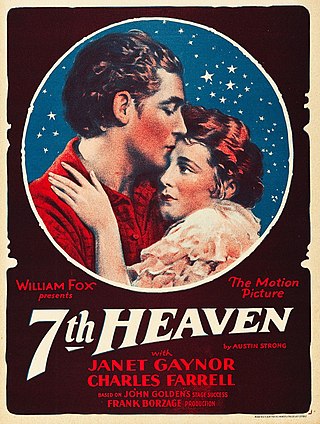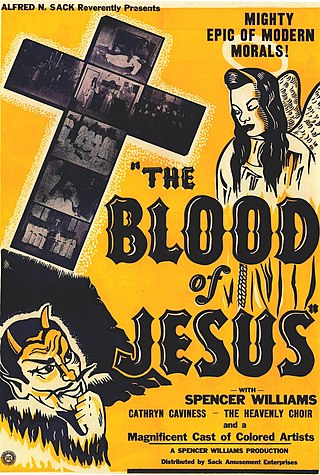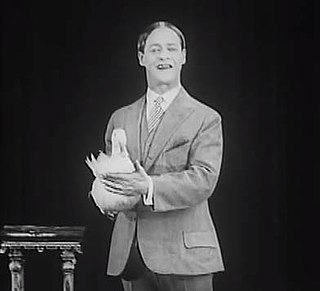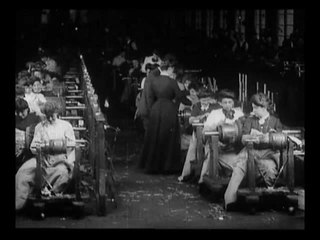
Charleston is the most populous city in the U.S. state of South Carolina, the county seat of Charleston County, and the principal city in the Charleston metropolitan area. The city lies just south of the geographical midpoint of South Carolina's coastline on Charleston Harbor, an inlet of the Atlantic Ocean formed by the confluence of the Ashley, Cooper, and Wando rivers. Charleston had a population of 150,227 at the 2020 census. The population of the Charleston metropolitan area, comprising Berkeley, Charleston, and Dorchester counties, was estimated to be 849,417 in 2023. It ranks as the third-most populous metropolitan statistical area in the state, and the 71st-most populous in the United States.

7th Heaven is a 1927 American synchronized sound romantic drama directed by Frank Borzage, and starring Janet Gaynor and Charles Farrell. While the film has no audible dialog, it was released with a synchronized musical score with sound effects using the Movietone sound system. The film is based upon the 1922 play Seventh Heaven, by Austin Strong and was adapted for the screen by Benjamin Glazer. 7th Heaven was initially released as a standard silent film in May 1927. On September 10, 1927, Fox Film Corporation re-released the film with a synchronized Movietone soundtrack with a musical score and sound effects.

Sunrise: A Song of Two Humans is a 1927 American synchronized sound romantic drama directed by German director F. W. Murnau and starring George O'Brien, Janet Gaynor, and Margaret Livingston. The film's plot follows a married farmer (O'Brien) who falls for a woman vacationing from the city (Livingston), who tries to convince him to murder his wife (Gaynor) in order to be with her. While the film has no audible dialog, it was released with a synchronized musical score with sound effects using the Movietone sound-on-film process. The story was adapted by Carl Mayer from the short story "The Excursion to Tilsit", from the 1917 collection with the same title by Hermann Sudermann.

The Blood of Jesus is a 1941 American independent fantasy drama race film written, directed by and starring Spencer Williams. The plot concerns a Baptist woman who, after being accidentally shot by her atheist husband, is sent to a crossroads, where Satan tries to lead her astray.

Jam Session is a 1942 short film, directed by Josef Berne, which shows Duke Ellington and his orchestra performing "C Jam Blues".

Jammin' the Blues is a 1944 American short film made by Gjon Mili and Norman Granz in which a number of prominent jazz musicians re-create the jam-session atmosphere of nightclubs and after-hours spots. It features Lester Young, Red Callender, Harry Edison, Marlowe Morris, Sid Catlett, Barney Kessel, Jo Jones, John Simmons, Illinois Jacquet, Marie Bryant and Archie Savage.

Theodore Case Sound Test: Gus Visser and his Singing Duck, also known as Gus Visser and His Singing Duck, is a 1925 American short musical comedy film starring vaudeville performer Gus Visser. The short is an early sound film, directed by Theodore Case while perfecting his variable density sound-on-film process. Case began working on his sound film process at the Case Research Lab in Auburn, New York, in 1921.

"The Saint Louis Blues" is a popular American song composed by W. C. Handy in the blues style and published in September 1914. It was one of the first blues songs to succeed as a pop song and remains a fundamental part of jazz musicians' repertoire. Benny Goodman, Louis Armstrong, Cab Calloway, Bing Crosby, Bessie Smith, Eartha Kitt, Count Basie, Glenn Miller, Guy Lombardo, Peanuts Hucko, Art Tatum, and the Boston Pops Orchestra are among the artists who have recorded it. The song has been called "the jazzman's Hamlet". Composer William Grant Still arranged a version of the song in 1916 while working with Handy.

Westinghouse Works, 1904 is a collection of American short silent films, each averaging about three minutes in length. The films were taken from April 18, 1904, to May 16, 1904, in Pittsburgh, Pennsylvania, and document various Westinghouse manufacturing plants. They were made by G. W. "Billy" Bitzer of the American Mutoscope and Biograph Company, were shown at the Westinghouse Auditorium at the 1904 St. Louis World's Fair, and may have been made for that purpose. At least 29 films were produced and 21 remain in the collection which is now a part of the National Film Registry of the Library of Congress.
Jabbo Smith was an American jazz musician, known for his virtuoso playing on the trumpet.

South Carolina is one of the Southern United States and has produced a number of renowned performers of jazz, rock, blues, R&B, country, bluegrass and other popular styles.

Edmund Thornton Jenkins (1894–1926) was an American composer who spent much of his life in Europe.

The Sex Life of the Polyp is a 1928 short film written and performed by Robert Benchley, based on a routine he first did in 1922. The short, which was adapted from an essay by Benchley, documents a dim-witted doctor attempting to discuss the sex life of a polyp to a women's club. This was the second of Benchley's 46 comedy short films, with six made for Fox, one each for Universal Pictures and RKO Radio Pictures, 29 for Metro-Goldwyn-Mayer, and nine for Paramount Pictures.
"The Charleston" is a jazz composition that was written to accompany the Charleston dance. It was composed in 1923, with lyrics by Cecil Mack and music by James P. Johnson, a composer and early leader of the stride piano school of jazz piano.

The Old Marine Hospital is a historic medical building at 20 Franklin Street in Charleston, South Carolina. Built 1831–33 to a design by Robert Mills, it was designated a National Historic Landmark in 1973 for its association with Mills, and as a high-quality example of Gothic Revival architecture. The hospital was built as a public facility for the treatment of sick sailors and other transient persons.

St. Louis Blues is a 1929 American two-reel short film starring Bessie Smith. Directed by Dudley Murphy, it is the only known film featuring Bessie Smith, and the soundtrack is her only recording not controlled by Columbia Records. An early sound film, it features an entirely African American cast, with Smith in the role of a woman left alone by her roving lover; in a speakeasy during the Prohibition era, the woman sings the W. C. Handy standard "St. Louis Blues".
Glimpse of the Garden is a 1957 five-minute short experimental film made by Marie Menken, showing film clips of a garden, with birds chirping for the soundtrack. In 1958, the film won an award at the Exposition Universelle et Internationale at Brussels. In 2007, the film was included in the annual selection of 25 motion pictures added to the National Film Registry of the Library of Congress being deemed "culturally, historically, or aesthetically significant" and recommended for preservation.

Commandment Keeper Church, Beaufort South Carolina, May 1940 is a 1940 short documentary film which shows religious services taking place in a South Carolina Gullah community.
As it has with every aspect of Charleston, South Carolina culture, the Gullah community has had a tremendous influence on Music in Charleston, especially when it comes to the early development of jazz music. In turn, the music of Charleston has had an influence on that of the rest of the country. The geechee dances that accompanied the music of the dock workers in Charleston followed a rhythm that inspired Eubie Blake's "Charleston Rag" and soon later James P. Johnson's "The Charleston", as well as the dance craze that defined a nation in the 1920s. "Ballin' the Jack", which was the popular dance in the years before "The Charleston", was written by native Charlestonian Chris Smith.
Julius J. "Geechie" Fields was an American jazz trombonist.
















